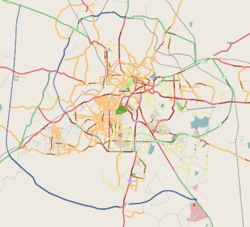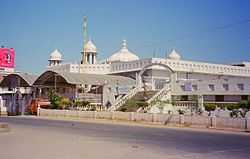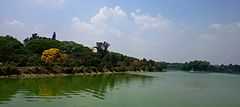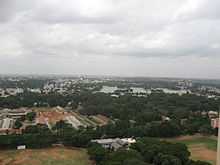Ulsoor
| Ulsoor ಹಲಸೂರು Halasuru | |
|---|---|
| neighbourhood | |
 Ulsoor | |
| Coordinates: 12°58′N 77°38′E / 12.97°N 77.63°ECoordinates: 12°58′N 77°38′E / 12.97°N 77.63°E | |
| Country | India |
| State | Karnataka |
| Metro | Bangalore |
| Languages | |
| • Official | Kannada |
| Time zone | IST (UTC+5:30) |
| Vehicle registration | KA-03 |
Ulsoor, or Halasuru, is one of the oldest neighbourhoods in the city of Bangalore. It is located in central Bangalore, and begins roughly near the eastern terminus of MG Road. It is renowned for its numerous temples and rather narrow streets.
History and name
The village of Bangalore is said to have been gifted to Kempe Gowda I (1513–1569), the founder of Bangalore, by the Vijayanagar emperors. The Ulsoor Lake was built by his successor, Kempe Gowda II, and is the only surviving tank built by the Gowda kings in Bangalore.[1] The first British military station was set up in Halasuru in 1807.[2]
There used to be a jackfruit orchard near the Ulsoor Lake, and the Kannada name for jackfruit being ‘Halasina Hannu’, the area came to be known as Halasuru. During the British rule, the name was anglicised to 'Ulsoor'.
Temples
There are several old temples in Ulsoor, which are scattered throughout the area. The oldest temple is the Halasuru Someshwara Temple, was built by Kempe Gowda I [3] in the 16th century and is a mixture of Hoysala, Chola and Vijayanagara architecture.
The Subramanya Temple, which is more than 800 years old, is also a prominent temple.
Gurudwara Sri Guru Singh Sabha

The largest Sikh shrine in Bangalore, the Sri Guru Singh Sabha, is situated on the banks of the Ulsoor Lake. The sprawling white building on the edges of the lake, is indeed a well known place on the City’s landscape. Sri Guru Singh Sabha Gurudwara at Ulsoor was built in 1943 by A G Russell and was inaugurated in 1945. "While the Jollys and the Sahani families were the main forces behind the construction of the Gurudwara, all the community members and the Kohli and Chandoks families financed it under the leadership of Ahulwalia and the Gill family from the neighboring Haudin Road Sikh foundation. It was only later in 1975, that the first floor of the Gurudwara was built. The monument is known for its splendid structure - it has added to the beauty of the area and Kensington Road where it is situated, which is also popularly known as Gurudwara Road. Being the biggest Gurudwara in City, a huge gathering of Sikhs come here on Wednesdays for prayer and the ‘langar’ on Sundays. All the devotees are offered free meals on Sundays, in what is known as the ‘Langar Sewa’. Around 1000 people visit the Gurudwara on Sunday mornings, while more than 2,000-3000 people visit in the afternoon and seek blessings post blessings they have Guru Ka Langar(Meals).
Demographics
The population of Ulsoor consisted of local Kannada speaking population.But the place has witnessed numerous immigrants since the British era from other regions. Most residents of Ulsoor are Tamils and the Lingua Franca happens to be Tamil in most cases. But in the last two decades the Tamil population is observed migrating to other areas.
Ulsoor lake
| Ulsoor Lake | |
|---|---|
 Ulsoor Lake | |
| Location | Bangalore, Karnataka |
| Coordinates | 12°58′53.3″N 77°37′9.17″E / 12.981472°N 77.6192139°E |
| Type | Stalewater |
| Primary inflows | Rainfall and city drainage |
| Primary outflows | Nala |
| Catchment area | 1.5 km2 (0.6 sq mi) |
| Basin countries | India |
| Surface area | 50 ha (123.6 acres) |
| Average depth | 19 ft (5.8 m) |
| Max. depth | 58 ft (18 m) |
| Shore length1 | 3 km (1.9 mi) |
| Surface elevation | 931 m (3,054.5 ft) |
| Islands | several islands |
| Settlements | Bangalore |
| 1 Shore length is not a well-defined measure. | |

Ulsoor Lake, one of the biggest lakes in Bangalore, is located on the eastern side of the city. It derives its name from the name of the locality it is situated, namely, Ulsoor, close to M G Road. It is spread over 50 ha (123.6 acres)) and has several islands. Even though the lake is dated to Kempegowdas’ time, the present lake was created by Sir Lewin Bentham Bowring, the then Commissioner of Bangalore.[3][4]
The lake was subject to several types of pollution threats.[5][6][7]
Water quality
The health of the lake eco-system was, therefore, monitored at six monitoring points on the lake for light, temperature, oxygen, nutrients and the type of aquatic plants that grow in the lake. During the study, it was noted that the lake which has catchment area of 1.5 km2 (0.6 sq mi) is fed by three drains at different locations; the first drain is from the Madras Engineering Group (MEG) Centre (of the Army), the second drain is from Jeevanahalli and the third drain is from Doddigunta and traverses through Kattariyamma garden, Godhandappa garden, Munivenkattappa garden, Muthamma garden, Muniamma garden, Kempurayana Garden and New Corporation colony and all these areas are within 1 km (0.6 mi) from the lake and inhabited by slums dwellers.[8] The study showed that the daytime DO was very high; varying between 0.2 and 4.5 mg/L. The saprobic nature of the lake water was confirmed by the P/R ratio which was less than one. Eutrophication of the lake was confirmed by further studies which indicated phosphate, nitrogen and chlorophyll levels to be high; with Blue green algae (which is toxic and utilises DO in the night) called the microcystis was noted from surface to bottom of the lake. This affected the aquatic plants and fish (only a few fish species remained). Further studies established the presence of high concentrations of zinc and the metal content in water samples, concentration of Zn, Cd, Cr, Pb and Cu content was found to be very high in sludge samples with depth sludge recorded as about 1.55 m (5.1 ft).[8]
These studies confirmed the need for urgent restoration and remedial actions in the form of:[8]
- Desilting of the lake is to eliminate contaminants
- Stop all encroachments of the lake with suitable fencing
- Only storm water should be allowed into the lake
- Army units should discontinue effluents from cattle house wash, cowdung wash and army mess wash and consider installation of a biogas plant.
- Plastic bags to be prevented from draining into the lake
- Sewage/manholes at identified locations to be closed.
- Drain water from slum around the lake to be treated before draining into the lake. Preferably, connect the slum storm water and wastewater drain to the nearby Cox Town sewage drain as it is close to the slums
- Prohibit submergence of idols during the festival season
- Remove all slum dwellers from region
- Cultivate and harvest fishes and aquatic plants to deplete the nitrogen and phosphate content
Restoration works
Restoration works, listed below, have resulted in improvements in the lake environment.[5][6][7]
- Aeration of wastewater that is lead into the lake
- Park and swimming pool improved
- Desilting of the lake bed and thus increasing depth and the capacity of the lake
- Installation of silt traps at the mouth of the storm water inlets
- Diversion of underground sewages lines from the eastern part of the City through 900 mm pipes bypassing the lake
- Restoration of Aquatic life by introduction of fish species natural to the lake and induction of suitable water plants
- Chain–link fencing to prevent people dumping garbage into the lake
- Boat training facility of Madras Engineering Group (MEG) improved
- Access to public from 9 am to 6 pm with holiday on Wednesday
It is reported that cleanliness drive has breathed new life to the lake.[7]
Other attractions
Some of the main thoroughfares in Ulsoor are CMH Road, Cambridge Road, Ulsoor Road and Old Madras Road. CMH Road has several fashion outlets and supermarkets and is the main shopping area for the residents of Ulsoor and the neighbouring Indiranagar.
MG Road, arguably the most well-known road in Bangalore, is a short walk from Ulsoor.
Location in Context
 |
Shivajinagar | Fraser Town / Cooke Town | Baiyappanahalli |  |
| Trinity Circle/M G Road | |
Indiranagar | ||
| ||||
| | ||||
| Richmond Town | Viveknagar / Domlur | Domlur |
Bangalore Metro Rail
There are two Bangalore Metro Rail stations[9] located in Ulsoor:
- Ulsoor (Located on Old Madras Road, at the end closer to CMH Road)
- Trinity (Located at Trinity Circle)
See also
- Halasuru Someshwara Temple
- Indiranagar
Referenced
- ↑ "Halasuru Lake".
- ↑ "The birth of a cosmopolitan city" The Hindu. 22 Mar. 2005
- ↑ 3.0 3.1 Mysore gazette compiled by B.L.Rice, page 72 Halasur
- ↑ Ulsoor lake: Clogged lung space
- ↑ 5.0 5.1 Ulsoor Lake restoration on schedule
- ↑ 6.0 6.1 Study area
- ↑ 7.0 7.1 7.2 Ulsoor lake: Clogged lung space
- ↑ 8.0 8.1 8.2 Status of Halasuru Lake Water Quality between 1996-97
- ↑ "Bangalore Metro: Route Map". Retrieved 24 July 2012.